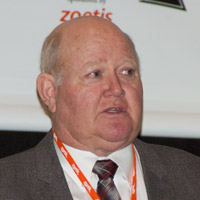The Ecology and Economics of Drought Management
Cattlemen's College® ranch management session explores ramifications of drought and what producers can do to prepare.
by Troy Smith for Angus Journal®
NASHVILLE, Tenn. (Feb. 4, 2014) — Maybe drought should be considered the norm, rather than the exception. Rod Heitschmidt wasn’t fooling when he made that suggestion to cattle producers attending the 2014 Cattle Industry Convention in Nashville, Tenn. Heitschmidt, former superintendent of the Fort Keogh Livestock and Range Research Laboratory at Miles City, Mont., and Richard Conner, a professor of rangeland ecology and economics at Texas A&M University, talked about drought mitigation during a Cattlemen’s College® session.

Rod Heitschmidt
“Ranchers and farmers are eternal optimists when it comes to rainfall. They always think it will rain again soon,” said Heitschmidt. “But most rangelands, at any given time, are within 30 days of a drought period.”
Reminding producers to have a drought plan, Heitschmidt advised them to become familiar with local and regional precipitation patterns and understand how the timing of rainfall events affects forage growth. Noting the importance of precipitation received in the fall (October and November) and spring (April and May), he said 75% of average annual forage growth at Miles City, Mont., occurs by June 6.
“Forage (growth) follows rain. We know what is likely to happen, based on precipitation patterns,” said Heitschmidt, advising producers to routinely estimate annual forage growth and set stocking rates accordingly.
Then, he said, producers should monitor forage growth and revise estimations. If destocking becomes necessary, make those decision in timely fashion. Don’t be too quick about restocking after conditions improve. It takes time for rangeland to recover.

Richard Conner
“Management after the drought is important, or more damage to range condition may occur,” added Heitschmidt.
In his discussion of the economics of drought mitigation, Richard Conner said producers must weigh the impacts to this year’s balance sheet, and subsequent years. Options may include selling some portion or all of the herd, and buying replacements at some future date. An alternative may be to relocate cattle temporarily. Another option is to buy feed. Conner said costs and benefits must be considered, as well as the income tax implications.
“A drought contingency plan should be thought out every year,” advised Conner. “I also recommend maintaining adequate financial or credit reserves to use in a drought situation.”
Editor’s Note: The above article was written under contract or by staff of the Angus Journal. It may not be reprinted without express
permission of the Angus Journal. To request reprint permission, contact the editor at 816-383-5200.
www.4cattlemen.com is an event coverage site provided by the Angus Journal editorial team, which publishes the Angus Journal, the Angus Beef Bulletin, the Angus Beef Bulletin EXTRA and the Angus Journal Daily. For questions about this site, to submit an article for our consideration, or to report a broken link, contact the editor at 816-383-5200; 3201 Frederick Ave., Saint Joseph, MO 64506.
The Angus Journal claims copyright
to this website as presented. We welcome educational venues and
cattlemen to link to this site as a service to their audience.

